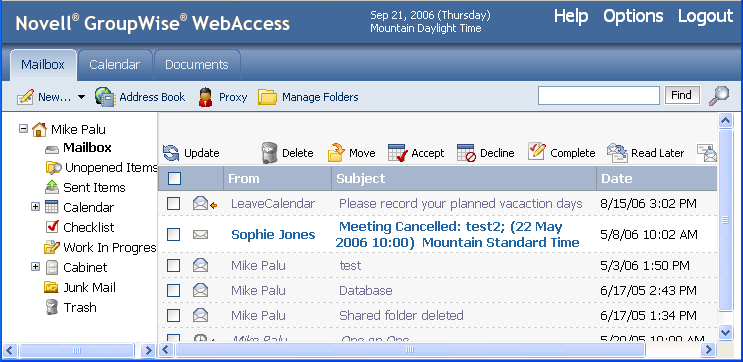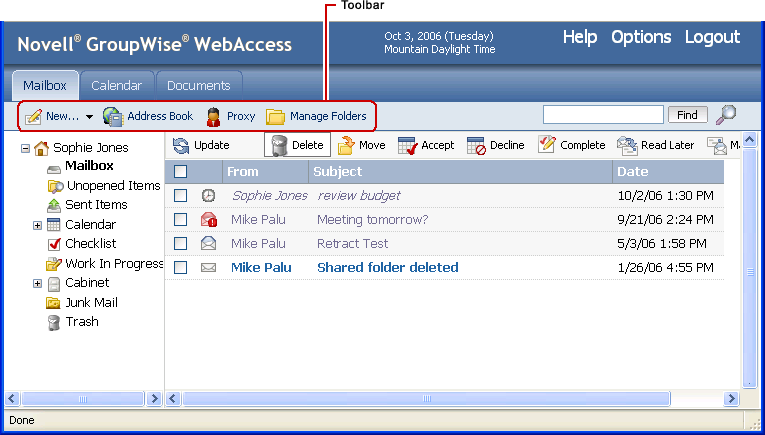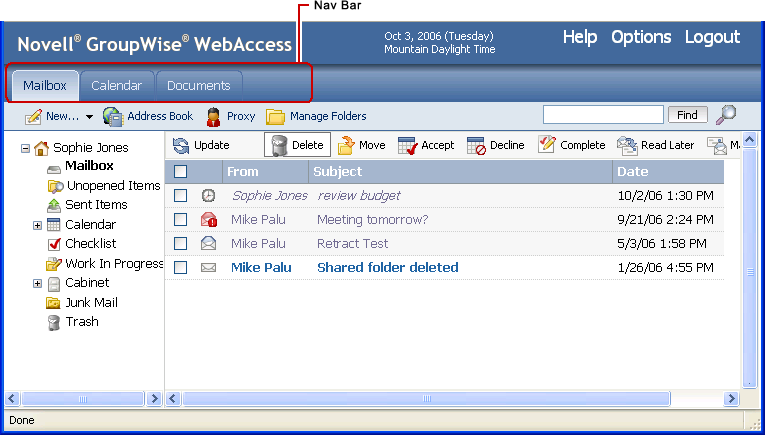1.3 Understanding the GroupWise WebAccess Main Window
When you open GroupWise WebAccess, you see the Main Window, shown below. This is your main work area in GroupWise. From the Main Window, you can read your messages, schedule appointments, view your Calendar, manage contacts, and much more.
Figure 1-2 Main Window

The Main Window has different components to help you accomplish your daily tasks. The following sections describe the various components you can use from the Main Window:
1.3.2 Toolbar
Figure 1-4 The GroupWise Toolbar

The toolbar lets you quickly accomplish common GroupWise tasks, such as opening the Address Book, sending mail messages, and managing folders.
1.3.3 Folder List
The Folder List displays the folders used to organize the items you send and receive. You can add additional folders to further help you organize your items. The Mailbox folder is the default folder that is opened when you first log in.
The following folders are displayed in the Folder List. You can open a folder by clicking the icon.
|
Icon |
Description |
|---|---|
|
Home |
Represents your GroupWise database. All folders in you Main Window are subfolders of your home user folder. |
|
|
Lists all items you receive, with the exception of scheduled items (appointments, tasks, and reminder notes) that you have accepted or declined. Accepted scheduled items and tasks are moved to the Calendar. The Mailbox is a system folder. |
|
|
Lists received items you have not yet opened. Unopened Items is a system folder. |
|
|
Lists items you send from the Mailbox and Calendar. Sent Items is a system folder. After you move a sent item from the Sent Items folder to another folder, it no longer displays in the Sent Items folder. (In the previous version of GroupWise WebAccess, the Sent Items folder was a query folder that listed sent items from all folders.) |
|
|
Lists all appointments, tasks, and notes in your Calendar. Calendar is a system folder. |
|
Task List |
|
|
|
Lists items you have moved to this folder. You can move any items (mail messages, phone messages, reminder notes, tasks, or appointments) to this folder and arrange them in the order you want. Each item is marked with a check box so that you can check items off as you complete them. Checklist is a system folder. In the previous version of GroupWise WebAccess, a Task List folder listed all the task items in your Mailbox and Calendar. Task List was a query folder. For more information, see Using the Checklist Folder. |
|
|
Lists personal folders you create. Cabinet is a system folder. |
|
|
Lists items that have been saved to be sent later. Work in Progress is a system folder. |
|
|
Lists e-mail items from addresses and Internet domains that are junked through Junk Mail Handling are placed in the Junk Mail folder. This folder is not created in the folder list unless a Junk Mail option is enabled. Junk Mail is a system folder. |
|
|
Lists all deleted mail and phone messages, appointments, tasks, documents, and reminder notes that have not yet been purged. Items in the Trash can be viewed, opened, or returned to your Mailbox before the Trash is emptied. (Emptying the Trash removes items in the Trash from the system.) Trash is a system folder. |
System Folders
The folders listed in the table are system folders, which are created by GroupWise and cannot be deleted or renamed.
For additional information about using folders, see Section 2.5, Using the Folder List.
Personal Folders
You can add additional folders to organize your items. For example, you could add a folder to your Cabinet to store all messages you receive regarding a specific project you are working on.
Shared Folders
You can share personal folders with other users. Recipients of the shared folder receive a notification explaining that you have shared the folder with them. They can then accept the folder or decline the folder.
Find Results Folders
In the Windows version of GroupWise, you can save the results of an item or document search in a folder. You cannot do this in GroupWise WebAccess. However, GroupWise WebAccess lets you view any Find Results folders you create in another version of GroupWise.
1.3.4 Item List
The Item List displays the contents of the folder that is currently open. By default, the most recent 20 items in the folder are displayed. If the folder contains more than 20 messages, a Display Next button appears at the bottom of the list. You can use it to display the next 20 messages, or you can choose to select more or less than 20 messages.
The icon next to each item indicates the item type, status, and priority. You click an item to open it. You can drag and drop items to move them. When you open an item, all actions you can perform on that item type are displayed at the top of the item view. For easy access, actions that you commonly perform on items are also displayed at the top of the Item List. You can select multiple items by clicking the boxes to the left of the items.
Whenever you select items in the Item List and perform an action on them, WebAccess updates the Item List. To refresh the list manually, open the folder again or click Update at the top of the list.
The following icons can be displayed in the Item List:

 Mailbox
Mailbox
 Unopened Items
Unopened Items
 Sent Items
Sent Items
 Calendar
Calendar
 Checklist
Checklist
 Cabinet
Cabinet
 Work in Progress
Work in Progress
 Junk Mail
Junk Mail
 Trash
Trash











































